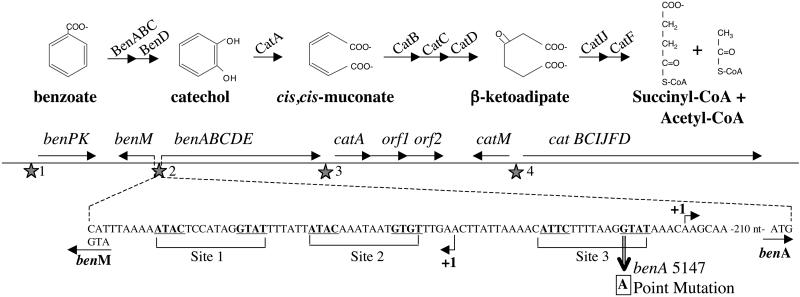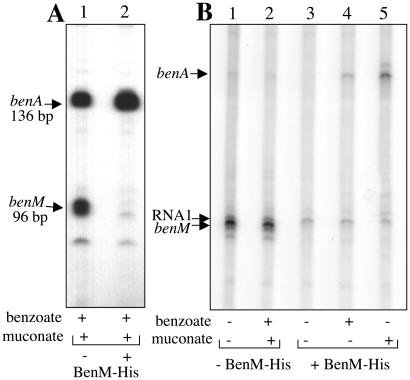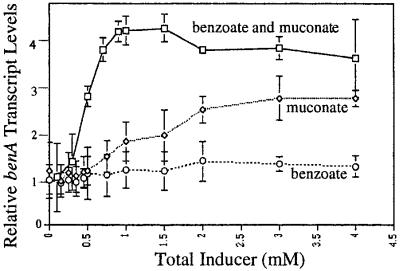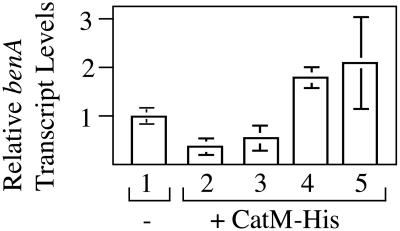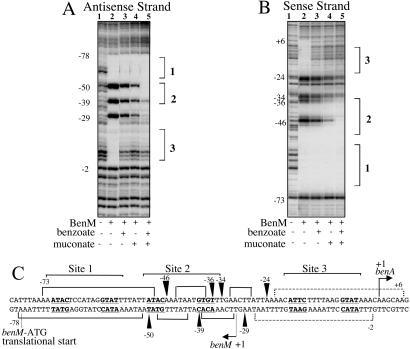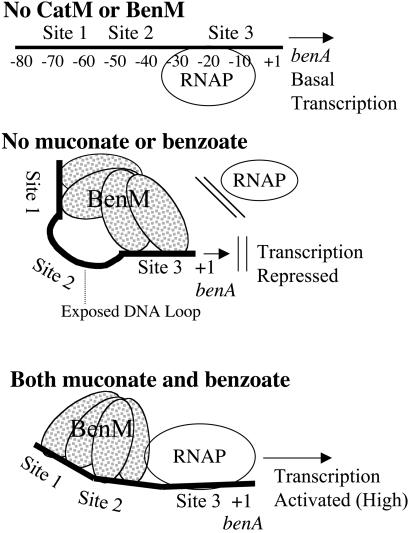Abstract
BenM is a LysR-type bacterial transcriptional regulator that controls aromatic compound degradation in Acinetobacter sp. ADP1. Here, in vitro transcription assays demonstrated that two metabolites of aromatic compound catabolism, benzoate and cis,cis-muconate, act synergistically to activate gene expression. The level of BenM-regulated benA transcription was significantly higher in response to both compounds than the combined levels due to each alone. These compounds also were more effective together than they were individually in altering the DNase I footprint patterns of BenM-DNA complexes. This type of dual-inducer synergy provides great potential for rapid and large modulations of gene expression and may represent an important, and possibly widespread, feature of transcriptional control.
LysR-type transcriptional activators control the expression of diverse genes and form one of the largest families of prokaryotic regulators (1). BenM, of the soil bacterium Acinetobacter sp. strain ADP1, belongs to a subclass of this family involved in aromatic compound catabolism by bacteria of at least four genera. Previous studies suggested that BenM might activate benA transcription synergistically in the presence of benzoate and cis,cis-muconate (2). Because this suggestion could not be conclusively demonstrated in vivo, purified BenM was used to investigate transcriptional activation in vitro.
BenM and a second LysR-type regulator, CatM, control a complex regulon with at least 16 genes for aromatic compound catabolism (3). BenM and CatM are 59% identical in sequence, and both respond to muconate to activate transcription at different loci (Fig. 1; ref. 4). At each locus, the relative importance of CatM and BenM varies. For example, both proteins seem to be equally important in the expression of catA and benP, whereas CatM is the major regulator of catB (2–4). This report focuses on the divergently transcribed benM and benA genes. Genetic evidence suggests that at this locus, BenM is the primary regulator, and CatM plays a lesser role. In mutants lacking BenM, CatM does not activate benABCDE expression to levels sufficient for growth on benzoate as the carbon source. However, CatM may stimulate low-level inducible expression of this operon and may repress basal transcription under some growth conditions (5). As reported here, the transcription of benA in response to two inducers did not require CatM, and the studies of transcriptional synergy centered on BenM.
Figure 1.
Benzoate degradation by ADP1 via the β-ketoadipate pathway. The chromosomal ben and cat genes encode proteins for benzoate catabolism. Four regions (stars) in a supraoperonic cluster (not drawn to scale) are regulated by both BenM and CatM. Transcription initiation sites (+1) of the divergent benA and benM genes are noted. A point mutation (G to A) of the benA5147 allele increases BenM-independent benA expression. Sites 1, 2, and 3, discussed in the text, resemble consensus binding sites for LysR-type regulators.
Regulators similar to BenM include CatR and ClcR of Pseudomonas putida which regulate the catabolism of catechol/phenol and 3-chlorocatechol, respectively (6–8). They are Class I transcriptional activators that contact a C-terminal region of the α-subunit of RNA polymerase (9). CatR and ClcR bind to distinct sites in their target promoter regions, the recognition and activation sites. Each regulator binds the recognition site under all conditions. When the regulator, with a coactivator, also binds the activation site, productive contacts with RNA polymerase increase transcription. A third site, the internal binding site, lies in structural genes regulated by CatR or ClcR and helps repress gene expression (7, 8). Multiple DNA-binding sites frequently occur for additional LysR-type proteins and for regulators in families represented by AraC/XylS, NarL, LuxR, and OmpR (10).
Transcriptional regulators often respond to one molecule in a fashion that alters protein binding in the promoter region. Although multiple effectors sometimes regulate gene expression (11–17), the combined effect of these compounds on transcriptional control by a single regulator is poorly understood. Synergistic effects on transcriptional regulation have previously been attributed to two distinct contacts made between RNA polymerase and a single DNA-bound activator or between RNA polymerase and two different activators, as reviewed in ref. 18. This type of synergy raises the possibility that a significant effect on transcription might result from diverse effectors altering the contacts between a single regulator and RNA polymerase.
As described here, BenM was the sole Acinetobacter protein required for the synergistic activation of benA expression in response to benzoate and muconate. Moreover, the BenM-benA DNase I footprint patterns with both compounds together were dramatically different from those with either compound alone. A model is presented in which benzoate and muconate influence the binding of BenM to different sites in the benA promoter region. The increased transcription in ADP1 caused by the second metabolite was physiologically significant and suggests that the response of individual transcriptional regulators to multiple effectors warrants further study.
Materials and Methods
Bacterial Strains and Growth Conditions.
Acinetobacter sp. strain ADP1 (BD413) and Escherichia coli strains and growth conditions have been described (2, 19, 20). A benM deletion was made by allelic replacement methods (2). A linear DNA fragment with a 359-bp benM deletion (1930 to 2289, GenBank AF009224 numbering) was used to create strain ACN389, whose ΔbenM chromosomal allele was confirmed by Southern blotting (21). With the same method, ACN389 was transformed with a PCR fragment bearing benM5205, an allele encoding BenM with a hexahistidine tag at the carboxyl terminus (BenM-His). Strain ACN205 was isolated with this chromosomal allele. The benM5205 PCR DNA was made after two initial reactions amplified wild-type DNA upstream and downstream of the insertion site for DNA encoding the hexahistidine tag. The tag-encoding DNA was added to the end of a primer in each reaction (primer sets: 5′-GCTAGTATTAATGACGGGAAT-3′ and 5′-TCAGTGGTGGTGGTGGTGGTGCCAGTTTGGCGGCTCAGT-3′; 5′-GGAACAGCGTGCGTTTAGTAC-3′ and 5-′CACCACCACCACCACCACTGACAAAAAACCCATTAGACT-3′). The two resultant fragments were combined for use as template in a third PCR. The short (not tag-encoding) primers from the first reactions amplified one fragment, encoding BenM-His, that was used to replace the corresponding region of ACN389.
BenM and CatM Purification.
The genes for BenM-His and C-terminally hexahistidine-tagged CatM (CatM-His) were PCR amplified with primers including NdeI and XhoI sites: 5′-TCAATTCATATGGAACTTAGACATCTCCGC-3′ and 5′-TCAATTCTCGAGCCAGTTTGGCGGCTCAGTAAA-3′ (benM-his); 5′-TCAATTCATATGGAACTAAGACACCTCAGA-3′ and 5′-TCAATTCTCGAGTTCGATGAGTGGCCTGATATG-3′ (catM-his). PCR products were ligated to pET21b (Promega) to make plasmids pBAC433 (benM-his) and pBAC430 (catM-his). BenM-His and CatM-His were expressed in E. coli BL21(DE3) (Stratagene). Cultures were grown to an OD600 of 0.2, and 0.2 mM isopropyl-β-d-thiogalactopyranoside was added. Cells were harvested after overnight growth and suspended in lysis buffer [20 mM Tris, pH 7.9/10% (vol/vol) glycerol/5 mM imidazole/500 mM NaCl]. After lysis by sonication, the extract was clarified by centrifugation. Clarified cell extract was applied to a Hi-Trap 5 ml metal chelating column (Amersham Pharmacia) charged with nickel. Proteins were eluted by the manufacturer's protocol. Standard methods were used for SDS/PAGE (21). Approximately 10–20 mg BenM-His or CatM-His was obtained at ≥95% purity per 1.5 liter of culture.
Native CatM and BenM were obtained at ≥95% purity after cation exchange and heparin-agarose chromatography (4). Some footprint reactions used partially pure proteins (22) and yielded the same results as those repeated with preparations that were ≥95% pure. In analytical gel filtration chromatography (4), benzoate and muconate (0.5 mM each) were added in the buffer when indicated.
Transcription Assays.
A single round in vitro transcription assay was used essentially as described (23). Plasmid pBAC346, derived from pMP7 (24), has the benAM region from 411 to 148 bp upstream of the start of benA translation. Plasmid pBAC400 has the same region of the benA5147 allele (2). These plasmid templates (10 nM) were digested with HindIII and used in transcription reactions (final volume, 17.5 μl) with 20 units RNase inhibitor (Promega), 3.5 μg acetylated BSA (Promega), 1 μg poly[dI-dC], and 0.4 units E. coli σ-70 RNA polymerase holoenzyme (Epicentre Technologies, Madison, WI), in 40 mM Hepes buffer, pH7.5, containing 2.7 mM DTT, 0.4 mM EDTA, 0.75 mM Tris, 50 mM NaCl, 10 mM MgCl2, 6.7 mM sodium phosphate, and 10% (vol/vol) glycerol. BenM-His (3 μM) or CatM-His (3 μM) were allowed to bind template DNA for 20 min at 35°C in the presence and absence of benzoate and/or muconate. RNA polymerase was added, and after 15 min, [α-32P]UTP (7 μM), UTP (20 μM), and the remaining nucleotides (ATP, GTP, and CTP, 250 μM) were added to initiate transcription. Heparin (1.5 μg per reaction) also was added at this time to prevent transcription reinitiation. After further incubation for 20 min, reactions were stopped and precipitated overnight at −80°C. Transcripts were analyzed by denaturing PAGE and were quantified with a PhosphorImager (Molecular Dynamics) and IMAGEQUANT V.1.2 software. Transcripts were normalized to an internal control present in all reactions, the RNA1 transcript encoded by the vector.
Analysis of Transcript Initiation.
Total RNA was isolated with Tri reagent (Sigma) from cells grown in LB broth with or without added 3 mM benzoate and/or muconate. For primer extensions, a primer, 5′-CGAATATCCATTTCAGCTTT-3′, complementary to sequences 130–149 bases upstream of the start of benA translation, was end-labeled with [γ-32P]ATP (Amersham Pharmacia) with T4 polynucleotide kinase (Promega). Unincorporated [32P]ATP was removed with a MicroSpin G-25 column (Amersham Pharmacia). Reactions, done with the Promega Primer Extension kit, were analyzed on 8% polyacrylamide, 7M urea sequencing gels (Stratagene). Sequencing reactions were done simultaneously with the fmol DNA Cycle Sequencing kit (Promega) and the same labeled primer as above with a plasmid-borne wild-type ben template. For benM analysis, 5′-GCTCCTCAACCACAGCCACA-3′, a primer complementary to sequences 43 to 24 bases upstream of its translational start, was used as described for benA.
For RNase protection assays, a 423-base RNA probe (from 345 bases upstream to 27 bases downstream of benA's translational start) was made with the MAXIscript kit (Ambion, Austin, TX). The probe was biotin-labeled with the BrightStar Psoralen method (Ambion). After hybridization of the probe (350 ng) to RNA (25 μg), the products were treated with RNase and visualized with the RPAII kit (Ambion).
DNase I Footprinting.
The benAM intergenic region, from 411 to 130 bases upstream of the benA translational start, was ligated to pUC19 (25) to make pBAC366. To label the antisense strand, pBAC366 was cut with EcoRI and dephosphorylated with calf intestinal alkaline phosphatase (Promega). The 5′ ends were phosphorylated with [γ-32P]ATP (Amersham Pharmacia) by T4 polynucleotide kinase. This DNA was cut with HindIII to release a singly end-labeled 248-bp fragment that was purified as described (26). To label the sense strand, plasmid pBAC373 was made by HindIII deletion of pBAC366. pBAC373 was cut with HindIII, end-labeled with [γ-32P]ATP, and a 221-bp promoter fragment was purified after digestion with EcoRI. The labeled fragments were incubated at 30°C for 30 min with various concentrations of BenM or CatM, with or without benzoate and/or muconate. DNase I footprinting reactions were carried out as described (27).
Results
BenM Is Tetrameric.
To test the functionality of BenM-His, which has a hexa-histidine tag at the carboxyl terminus, the corresponding gene was used to replace the wild-type benM on the chromosome of Acinetobacter sp. strain ADP1. The resulting strain, ACN205, grew on benzoate as the sole carbon source with a doubling time comparable to that of the wild type, approximately 90 min. Because strains lacking BenM do not grow on benzoate (2), BenM-His seemed to activate ben gene expression in vivo. BenM-His was expressed in E. coli and purified to homogeneity. The deduced size of the monomer, 44 kDa, was confirmed by SDS/PAGE (data not shown). With analytical gel filtration in the absence or presence of both benzoate and muconate in the chromatography buffer, BenM-His eluted as a single peak corresponding to 180 kDa (data not shown). Thus, BenM-His was inferred to be a tetramer regardless of the presence of the effectors. Most LysR-type regulators are dimers or tetramers (28).
In Vitro Transcription of benA and benM.
A single-round in vitro transcription assay was developed with σ70-saturated RNA polymerase from E. coli and a linear DNA template bearing the promoters of the divergently transcribed benM and benA. To optimize the assay, initial studies used benA5147, an allele with a point mutation allowing high-level BenM-independent benA expression (2). As predicted, BenM was not needed for transcription of this template (Fig. 2A, lane 1).
Figure 2.
In vitro transcription of benA and benM. Linear DNA templates carried the benA5147 allele (A) or the wild-type benA (B). The presence (+) or absence (−) of BenM-His (3 μM), benzoate (2 mM), and muconate (2 mM) is noted.
To confirm the benM and benA transcript assignments, transcript initiation sites were determined. Primer extension methods with benA yielded a cDNA product with RNA from the wild-type strain grown in the presence, but not the absence, of benzoate and/or muconate (data not shown). The size of the cDNA corresponded to transcript initiation 216 bases upstream of the benA translational start. This site (Fig. 1) coincided exactly with that predicted from a sequence comparison with the CatM-regulated catB gene (2). RNase protection assays confirmed a single transcriptional start site, at the same approximate location, for the benABCDE operon (data not shown). The size of the benA transcript in the in vitro assay (Fig. 2) was consistent with the identified start site.
Conventional primer extension methods failed to detect benM transcripts, most likely because of low gene expression from negative autoregulation. Thus, a nonradioactive in vitro transcription reaction in the absence of BenM was used to generate the RNA template for primer extension reactions. In these reactions, a single cDNA product indicated that benM transcription initiates 46 bases upstream of the translational start site, depicted in Fig. 1 (data not shown). This position is consistent with the benM transcript size in the in vitro assay (Fig. 2).
When BenM-His was included in the transcription assay, the benM transcript levels were reduced 4- to 6-fold (Fig. 2A, lane 2), consistent with negative autoregulation of most LysR-type regulators (1). BenM-His with benzoate and muconate caused a 2- to 3-fold increase in benA5147 expression (Fig. 2A, lane 2). Because BenM repressed its own gene expression, the mutation did not prevent the regulator from binding to the benA-benM promoter region. The mutation's position, −8 relative to benA transcription initiation, suggests an effect on promoter strength. The inference that the mutation increases the affinity of RNA polymerase for the promoter is supported by studies of the wild-type promoter, where benA was not transcribed well without BenM (Fig. 2B).
Weak transcription of the wild-type benA in the absence of BenM was unaffected by benzoate and muconate (Fig. 2B, lanes 1 and 2). Without these compounds, BenM-His reduced the low benA transcript level (Fig. 2B, lane 3). When quantified, the reduction in basal benA expression was ≈2-fold. Similarly, BenM repressed the basal expression of a chromosomal benA∷lacZ transcriptional fusion in vivo (unpublished data). The wild-type promoter, like benA5147, also resulted in negative benM autoregulation that was not significantly affected by benzoate or muconate (Fig. 2B).
Synergistic Activation of benA by BenM with Benzoate and Muconate.
BenM with benzoate or muconate activated benA expression (Fig. 2B, lanes 4 and 5). Muconate was more effective as the sole coactivator, as shown in vivo (2). Assays with BenM-His and different concentrations of benzoate and/or muconate revealed that benzoate and muconate together had a synergistic effect on benA expression (Fig. 3). For example, neither 0.5 mM benzoate nor 0.5 mM muconate significantly increased BenM-mediated transcriptional activation from the benA promoter. However, with 0.25 mM of each (0.5 mM total inducer concentration), benA transcript levels were ≈3-fold higher than those of the internal control, RNA1. Similar results were obtained with native BenM in this assay (data not shown).
Figure 3.
Synergistic transcriptional activation of benA by BenM-His. The benA transcript levels from in vitro reactions are reported relative to those of an internal control, RNA1. Each value is the average of three reactions. Reactions contained benzoate (○), muconate (◊) or both (□). In the latter reactions, the total inducer concentration was the combined sum of equimolar amounts of benzoate and muconate.
In additional studies with BenM-His, transcription reactions contained either 0.5 mM benzoate or muconate, and the concentration of the other compound varied from 0 to 4 mM. In each experimental set, maximal BenM-His-mediated transcriptional activation occurred when both compounds were at or near equimolar concentrations (data not shown). Although muconate is more effective than benzoate as the sole effector, both may play equal roles in the dual compound synergism. These studies demonstrate that BenM is the sole Acinetobacter protein required for the dual compound response.
BenM-His was sufficient for high-level transcription, regardless of CatM's role in benA regulation. Because the ability of CatM to activate low-level benA expression had been inferred previously from genetic studies, the in vitro transcription assay also was used to clarify CatM-mediated regulation of benA. The sequence similarity between CatM and BenM raised the question of whether CatM, like BenM, could respond to both benzoate and muconate. As described next, biochemical analysis confirmed that CatM does not mediate the high-level benA expression that depends on both inducers.
Regulation of benA by CatM.
When CatM-His, with a hexa-histidine tag at the carboxyl terminus, was used in the transcription assay without inducers, it repressed benA transcription ≈2-fold (Fig. 4, Bar 2). CatM-His did not respond to benzoate (Bar 3), even when the benzoate concentration was increased up to 3 mM (not shown). Muconate caused an increase in benA transcription (Bar 4) that was not significantly altered by added benzoate (Bar 5). These results are consistent with studies of a chromosomal benA∷lacZ transcriptional fusion in different genetic backgrounds (2, 5). The level of benA expression achieved with muconate in vitro was similar for CatM-His and BenM-His. For example, either regulator with 1 mM muconate yielded benA transcript levels ≈2-fold higher than those of RNA1 (Figs. 3 and 4). However, in mutants lacking BenM, CatM-activated benA expression is insufficient to support growth on benzoate (2, 5). The growth-limiting factor in these strains seems to be the level of CatM-activated benA expression, because several point mutations each allow BenM-independent growth on benzoate by increasing CatM-dependent muconate-activated benA transcription (2, 5). Thus, the ability of BenM, but not CatM, to respond synergistically to benzoate in combination with muconate is significant, because it raises benA expression above the threshold needed for growth.
Figure 4.
Transcriptional activation of benA by CatM-His. The benA transcript levels from in vitro reactions are reported relative to those of the RNA1 control. Inducers were added at a total concentration of 1 mM as follows: benzoate and muconate (Bar 1 and Bar 5), none (Bar 2), benzoate (Bar 3), and muconate (Bar 4). Each bar represents the average of three reactions.
BenM and benA Interactions.
In DNase I footprints, BenM protected a large benA promoter region from cleavage in the absence of inducers. This protected region, with the exception of several sites hypersensitive to DNase I cleavage, extended on the antisense strand from nucleotides −78 to −2, with respect to the benA transcriptional start site (Fig. 5A, lane 2). On the sense strand, this region extended from −73 to +6 (Fig. 5B, lane 2). Three sites in this region resemble a consensus binding sequence for LysR-type regulators of the subclass to which BenM and CatM belong (29). These sites are marked in Figs. 1 and 5. In the absence of effectors, the BenM tetramer may bind to two areas with dyad symmetry: Site 1, which exactly matches the consensus, ATAC-N7-GTAT, and Site 3, which differs at one position, ATTC-N7-GTAT. Each half-site of dyad symmetry may be recognized by a helix-turn-helix DNA-binding motif predicted within the N-terminal region of a BenM monomer (28, 30).
Figure 5.
DNase I footprinting of native BenM at benA. DNase I-cleaved DNA was labeled on the antisense (A) or sense (B) strand of the benA promoter region. The presence (+) or absence (−) of BenM (0.15 μM), benzoate, and muconate in the reactions is noted. Inducers were added at a concentration of 1 mM in each reaction. The BenM binding Sites 1, 2, and 3 are discussed in the text. (C) Nucleotides protected from DNase I digestion in both the absence and presence of inducers are indicated by solid brackets immediately above or below the benA sequence. Nucleotides protected from DNase I cleavage only in the absence of inducers are indicated by dotted brackets. Solid triangles show sites that were hypersensitive to DNase I digestion.
The centers of binding Sites 1 and 3, separated by 52 bp, should be on the same side of the DNA helix. The simultaneous binding of a BenM tetramer to both sites would presumably result in the intervening DNA forming an exposed loop accessible to DNase I. Sites hypersensitive to cleavage were observed at −50, −39, and −29 on the benA antisense strand, and positions −46, −36, −34, and −24 on the sense strand (Fig. 5), consistent with the proposed model (Fig. 6). Nucleotides on the outer edge of the exposed loop would be rendered hypersensitive to DNase I cleavage at regular intervals of approximately 10 to 11 nucleotides, the distance of a DNA helical turn. As observed, the hypersensitive sites on the complementary strands would be similarly positioned but skewed slightly relative to each other. Binding of the regulator to Site 3 in the absence of inducers would block the benA promoter and repress basal gene expression, as observed in vivo and in vitro. A similar benA DNase I footprint was generated by CatM in the absence of inducers (data not shown). This protection pattern most likely results from CatM recognizing similar DNA sequences to BenM (3) and accounts for CatM's repression of benA expression in vitro (Fig. 4) and in vivo under noninducing conditions (5).
Figure 6.
Model of benA regulation. This depiction of BenM's ability to repress or activate benA transcription by affecting interactions between the promoter DNA and RNA polymerase (RNAP) is based on data from DNase I footprints and in vitro transcription assays.
Alteration of BenM–benA Interactions by Inducers.
With benzoate and/or muconate in the footprint reactions, BenM no longer fully protected the Site 3 region from cleavage (Fig. 5 A and B, lanes 3–5). These inducible changes should improve the access of RNA polymerase to the promoter. In contrast, the Site 1 region remained protected by BenM under all conditions. This finding is similar to the inducer-independence of CatR and ClcR in binding their promoter recognition sites (7). BenM bound to Site 1 should repress benM expression. Protection in this region was consistent with the inducer-independence of the negative autoregulation.
With both benzoate and muconate in the BenM-benA footprint reactions, there was a dramatic loss of hypersensitivity to DNase I cleavage (Fig. 5 A and B, lanes 5). Positions −50 and −29 (antisense strand) and −46 (sense strand) were completely protected from DNase I cleavage when both effectors were present. This region (Site 2) contains the sequence ATAC-N7-GTGT, which differs from the consensus binding sequence at one position. Thus, in the presence of both muconate and benzoate, the BenM tetramer bound to Sites 1 and 2 (Fig. 6), whose centers, 21 bp apart, should be on the same face of the DNA helix. The short region of intervening DNA between these close sites would not form a loop, which would account for the absence of hypersensitivity to DNase I cleavage in this region when both muconate and benzoate are present.
BenM bound to Site 2 could activate transcription via contacts with RNA polymerase, as occurs for Class I activators (9, 23, 31–34). Consistent with a Class I type of activation, the −35 region of benA does not match the consensus for promoters with high affinity for RNA polymerase. Acinetobacter sp. strain ADP1 promoters, although not well characterized, should resemble those of E. coli. These bacteria have a relatively close evolutionary relationship (both in the γ-subdivision of the Proteobacteria), they have similar GC content, and E. coli RNA polymerase transcribes and regulates benA in vitro.
The patterns of protection from DNase I cleavage afforded by BenM with benzoate or muconate alone were intermediate between those in the absence of inducers and in the presence of both compounds. The simultaneous binding of BenM to Sites 1 and 3 in the presence of either inducer was indicated by some hypersensitivity to DNase I cleavage and by partial protection of the Site 3 region (Fig. 5 A and B, lanes 3 and 4). However, the relative amount of BenM that was bound to both Sites 1 and 3 was highest in the absence of inducers and was reduced by either benzoate or muconate. This reduction was evidenced by a decrease in the extent of Site 2 hypersensitivity and in the level of Site 3 protection.
Discussion
An equilibrium may exist between a “repressed” benA conformation with BenM bound to Sites 1 and 3, and an “activated” conformation with BenM bound to Sites 1 and 2 (Fig. 6). Either benzoate or muconate seems to shift the repressed BenM-benA complex toward the conformation needed for transcriptional activation. However, the dual inducer synergy apparently results from the significantly increased effectiveness of both compounds in mediating the shift between the alternative DNA–protein complexes in comparison to the ability of either compound individually. In the in vitro transcription assay, high levels of benA transcription (relative transcript levels at least 3-fold greater than those from the RNA1 internal control, Fig. 3) were observed only when both benzoate and muconate were present. In the footprint reactions, complete protection of the Site 2 region from DNase I cleavage was obtained only when both compounds were present. CatM did not respond to benzoate in the transcription assay (Fig. 4), nor did it respond to benzoate in footprinting reactions at benA (data not shown). The lack of response to benzoate correlated with the inability of CatM to activate high-level benA expression. Moreover, CatM, even with a high muconate concentration, was unable to eliminate the benA DNase I hypersensitivity that was accomplished by BenM with both benzoate and muconate (data not shown).
Muconate presumably binds to BenM in a protein region whose sequence resembles that of CatM and other regulators that respond to muconate or halogenated-muconate (2). It is not clear whether benzoate also binds to this site or to a different region of the protein. Future studies are needed to clarify the nature of coactivator binding. Nevertheless, both compounds may “lock” the BenM tetramer into an active conformation. The simultaneous binding of benzoate and muconate may alter the conformation of the oligomer in a fashion that significantly changes the regulator–DNA and regulator–polymerase interactions to activate high levels of benA transcription.
The binding of BenM to the benA Site 1 regardless of the coactivators is reminiscent of the “light-switch” model for AraC-regulated arabinose utilization in E. coli. In the absence of arabinose, AraC binds two well separated sites in its target promoter region and represses ara gene expression. In the presence of arabinose, AraC binds two closely spaced sites, resulting in transcriptional activation. Because AraC is already bound to the promoter region, the response to arabinose occurs rapidly (35, 36). Such rapid response also should occur for BenM, which may further modulate the level of transcriptional activation, depending on the combination of effectors present.
Several activators in BenM's LysR-type subclass may respond to multiple effectors. For example, CbeR (11) and CbnR (12) of Burkholderia sp. NK8 and Ralstonia eutropha NH9, respectively, respond to muconate, benzoate, and/or chloro-substituted versions of these compounds. Each regulator, involved in chlorobenzoate degradation, seems to recognize more than one inducer. At least for BenM, the synergistic response to benzoate and muconate argues against a broad substrate-recognition model in which the response to multiple compounds results simply from a loose fit between each effector and the inducer-binding domain of the regulator.
Transcriptional regulators not involved in aromatic compound metabolism also respond to multiple signals. Examples include IlvY (13), AlsR (14), XapR (15), BkdR (16), and GalR (17). However, the possibility that combinations of inducers improve the effectiveness of transcriptional regulation by these proteins remains to be explored. In prokaryotic and eukaryotic systems, synergistic transcriptional responses can be elicited by RNA polymerase making multiple contacts with a single protein or with multiple activator proteins (18). Thus, it is not surprising to discover that a single regulator can respond synergistically to distinct effectors, presumably through combined effects on regulator-RNA polymerase contact.
With BenM, the partial activation of gene expression in response to a single effector may prime the system for the rapid and large modulation of transcriptional levels in response to the second effector. Benzoate is only one of many aromatic compounds degraded via the catechol branch of the β-ketoadipate pathway (37). Tight transcriptional control is needed to regulate benzoate degradation in environments with multiple growth substrates to prevent the build up of toxic metabolites, such as muconate (38). Thus, the synergistic response of BenM to two pathway metabolites, muconate and benzoate, provides an elegant mechanism for fine tuning transcription in a complex catabolic pathway.
Acknowledgments
We thank Todd Clark, Nathaniel Cosper, and Cory Momany for help with protein purification, Christina DeStefano Shields for strain construction, and Mary Kelly and Mark Schell for help with DNase I footprints and analysis. This work was supported by National Science Foundation Grant MCB-9808784.
Abbreviations
- BenM-His
BenM-histidine tagged
- CatM-His
CatM-histidine tagged
Footnotes
This paper was submitted directly (Track II) to the PNAS office.
References
- 1.Schell M A. Annu Rev Microbiol. 1993;47:597–626. doi: 10.1146/annurev.mi.47.100193.003121. [DOI] [PubMed] [Google Scholar]
- 2.Collier L S, Gaines G L, III, Neidle E L. J Bacteriol. 1998;180:2493–2501. doi: 10.1128/jb.180.9.2493-2501.1998. [DOI] [PMC free article] [PubMed] [Google Scholar]
- 3.Romero-Arroyo C E, Schell M A, Gaines G L, III, Neidle E L. J Bacteriol. 1995;177:5891–5898. doi: 10.1128/jb.177.20.5891-5898.1995. [DOI] [PMC free article] [PubMed] [Google Scholar]
- 4.Clark T J, Momany C, Neidle E L. Microbiology. 2002;148:1213–1223. doi: 10.1099/00221287-148-4-1213. [DOI] [PubMed] [Google Scholar]
- 5.Cosper N J, Collier L S, Clark T J, Scott R A, Neidle E L. J Bacteriol. 2000;182:7044–7052. doi: 10.1128/jb.182.24.7044-7052.2000. [DOI] [PMC free article] [PubMed] [Google Scholar]
- 6.Parsek M R, Kivisaar M, Chakrabarty A M. Mol Microbiol. 1995;15:819–828. doi: 10.1111/j.1365-2958.1995.tb02352.x. [DOI] [PubMed] [Google Scholar]
- 7.McFall S M, Chugani S A, Chakrabarty A M. Gene. 1998;223:257–267. doi: 10.1016/s0378-1119(98)00366-7. [DOI] [PubMed] [Google Scholar]
- 8.Tover A, Zernant J, Chugani S A, Chakrabarty A M, Kivisaar M. Microbiology. 2000;146:173–183. doi: 10.1099/00221287-146-1-173. [DOI] [PubMed] [Google Scholar]
- 9.Ishihama A. J Bacteriol. 1993;175:2483–2489. doi: 10.1128/jb.175.9.2483-2489.1993. [DOI] [PMC free article] [PubMed] [Google Scholar]
- 10.Chen Q, Kadner R J. J Bacteriol. 2000;182:4430–4436. doi: 10.1128/jb.182.16.4430-4436.2000. [DOI] [PMC free article] [PubMed] [Google Scholar]
- 11.Francisco P, Ogawa N, Suzuki K, Miyashita K. Microbiology. 2001;147:121–133. doi: 10.1099/00221287-147-1-121. [DOI] [PubMed] [Google Scholar]
- 12.Ogawa N, McFall S M, Klem T J, Miyashita K, Chakrabarty A M. J Bacteriol. 1999;181:6697–6705. doi: 10.1128/jb.181.21.6697-6705.1999. [DOI] [PMC free article] [PubMed] [Google Scholar]
- 13.Wek R C, Hatfield G W. J Biol Chem. 1986;261:2441–2450. [PubMed] [Google Scholar]
- 14.Ramos C, Molina L, Molbak L, Ramos J L, Molin S. FEMS Microbiol Ecol. 2000;34:91–102. doi: 10.1111/j.1574-6941.2000.tb00758.x. [DOI] [PubMed] [Google Scholar]
- 15.Jorgensen C, Dandanell G. J Bacteriol. 1999;181:4397–4403. doi: 10.1128/jb.181.14.4397-4403.1999. [DOI] [PMC free article] [PubMed] [Google Scholar]
- 16.Madhusudhan K T, Luo J, Sokatch J R. J Bacteriol. 1999;181:2889–2894. doi: 10.1128/jb.181.9.2889-2894.1999. [DOI] [PMC free article] [PubMed] [Google Scholar]
- 17.Adhya S. Annu Rev Genet. 1989;23:227–250. doi: 10.1146/annurev.ge.23.120189.001303. [DOI] [PubMed] [Google Scholar]
- 18.Ptashne M, Gann A. Nature (London) 1997;386:569–577. doi: 10.1038/386569a0. [DOI] [PubMed] [Google Scholar]
- 19.Juni E, Janik A. J Bacteriol. 1969;98:281–288. doi: 10.1128/jb.98.1.281-288.1969. [DOI] [PMC free article] [PubMed] [Google Scholar]
- 20.Shanley M S, Neidle E L, Parales R E, Ornston L N. J Bacteriol. 1986;165:557–563. doi: 10.1128/jb.165.2.557-563.1986. [DOI] [PMC free article] [PubMed] [Google Scholar]
- 21.Sambrook J, Fritsch E F, Maniatis T. Molecular Cloning: A Laboratory Manual. 2nd Ed. Plainview, NY: Cold Spring Harbor Lab. Press; 1989. [Google Scholar]
- 22.Collier L S. Ph.D. thesis. Univ. of Georgia; 2000. [Google Scholar]
- 23.Chugani S A, Parsek M R, Hershberger C D, Murakami K, Ishihama A, Chakrabarty A M. J Bacteriol. 1997;179:2221–2227. doi: 10.1128/jb.179.7.2221-2227.1997. [DOI] [PMC free article] [PubMed] [Google Scholar]
- 24.Hershberger C D, Ye R W, Parsek M R, Xie Z D, Chakrabarty A M. Proc Natl Acad Sci USA. 1995;92:7941–7945. doi: 10.1073/pnas.92.17.7941. [DOI] [PMC free article] [PubMed] [Google Scholar]
- 25.Yanisch-Perron C, Vieira J, Messing J. Gene. 1985;33:103–113. doi: 10.1016/0378-1119(85)90120-9. [DOI] [PubMed] [Google Scholar]
- 26.Hoover T R, Santero E, Porter S, Kustu S. Cell. 1990;63:11–22. doi: 10.1016/0092-8674(90)90284-l. [DOI] [PubMed] [Google Scholar]
- 27.Wang Y K, Hoover T R. J Bacteriol. 1997;179:5812–5819. doi: 10.1128/jb.179.18.5812-5819.1997. [DOI] [PMC free article] [PubMed] [Google Scholar]
- 28.Hryniewicz M M, Kredich N M. J Bacteriol. 1995;177:2343–2353. doi: 10.1128/jb.177.9.2343-2353.1995. [DOI] [PMC free article] [PubMed] [Google Scholar]
- 29.Coco W M, Parsek M R, Chakrabarty A M. J Bacteriol. 1994;176:5530–5533. doi: 10.1128/jb.176.17.5530-5533.1994. [DOI] [PMC free article] [PubMed] [Google Scholar]
- 30.Pabo C O, Sauer R T. Annu Rev Biochem. 1992;61:1053–1095. doi: 10.1146/annurev.bi.61.070192.005201. [DOI] [PubMed] [Google Scholar]
- 31.Tao K, Fujita N, Ishihama A. Mol Microbiol. 1993;7:859–864. doi: 10.1111/j.1365-2958.1993.tb01176.x. [DOI] [PubMed] [Google Scholar]
- 32.Gussin G N, Olson C, Igarashi K, Ishihama A. J Bacteriol. 1992;174:5156–5160. doi: 10.1128/jb.174.15.5156-5160.1992. [DOI] [PMC free article] [PubMed] [Google Scholar]
- 33.Shi X, Bennett G N. J Bacteriol. 1994;176:7017–7023. doi: 10.1128/jb.176.22.7017-7023.1994. [DOI] [PMC free article] [PubMed] [Google Scholar]
- 34.McFall S M, Parsek M R, Chakrabarty A M. J Bacteriol. 1997;179:3655–3663. doi: 10.1128/jb.179.11.3655-3663.1997. [DOI] [PMC free article] [PubMed] [Google Scholar]
- 35.Schleif R. Trends Genet. 2000;16:559–565. doi: 10.1016/s0168-9525(00)02153-3. [DOI] [PubMed] [Google Scholar]
- 36.Harmer T L, Schleif R. J Biol Chem. 2001;276:4886–4888. doi: 10.1074/jbc.M007956200. [DOI] [PubMed] [Google Scholar]
- 37.Harwood C S, Parales R E. Annu Rev Microbiol. 1996;50:553–590. doi: 10.1146/annurev.micro.50.1.553. [DOI] [PubMed] [Google Scholar]
- 38.Gaines G L, III, Smith L, Neidle E L. J Bacteriol. 1996;178:6833–6841. doi: 10.1128/jb.178.23.6833-6841.1996. [DOI] [PMC free article] [PubMed] [Google Scholar]



